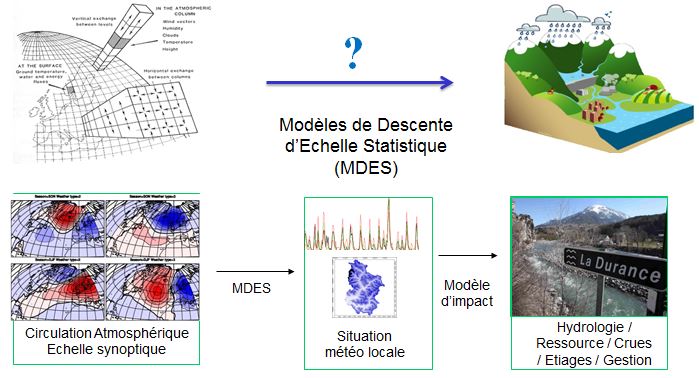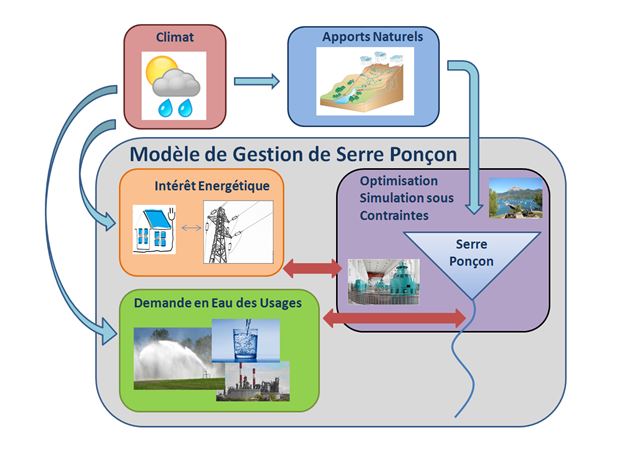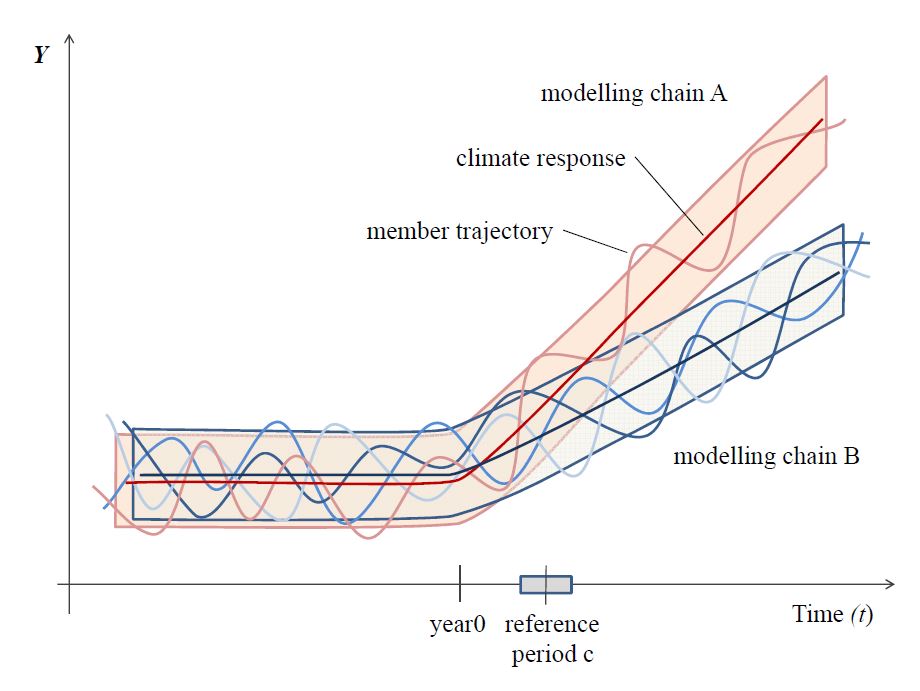SCIENTIFIC AND TECHNICAL APPROACH
Regional climate simulation
Different versions of 3 Statistical Downscaling Models were developed for and used in RIWER2030:
- analog developed by EDF and LTHE during previous collaborations (Obled et al., 2002),
- dsclim developed by CERFACS (BoÚ, 2007) and adapted for RIWER2030 by (Lafaysse, 2011) et
- d2gen, developed at EPFL and LTHE by (Mezghani and Hingray, 2009).
These SDMs allow for the generation of multivariate scenarios times series for several surface meteorological variables (e.g. precipitation, temperature, wind, radiation). To compare these SDMs, we developed a multicriteria evaluation framework, which comprises direct and indirect evaluations, testing respectively the SDM ability 1) to reproduce statistical characteristics of observed variables and 2) to provide relevant scenarios with respect to hydrology. We estimated also the temporal transferability of the model for an application in a modified climate context. Evaluation are finally multirealisations because of the statistical nature of statistical links (Lafaysse et al., 2014).

Figure: Principle of Statistical Downscaling Models (SDM) for local climate projections.
Modelling the Management of the Serre Ponšon Reservoir system
An integrated model was developed within RIWER2030 for the simulation of the current management of the reservoir. It allows evaluating the sustainability of the system by comparison of the performance of an optimal management strategy for past and future periods. The strategy results from the identification of dates and water uses for which it is most interesting to allocate a part of the resource. This strategy is obtained from dynamic programming so as to account for multiple objectives and constraints (low flow maintenance, agriculture, drinking water, hydroelectricity production, summer tourism).

Figure: Components of the simplified simulation model used for the simulation of the integrated management of the Serre Ponšon multipurpose water reservoir system(Franšois, 2013).
Uncertainty analysis
Uncertainties are quantified via a ensemble of hydroclimatic projections obtained for 1860-2100 at a daily time step with
with 11 climate experiments of the EU ENSEMBLE project,
different versions of 3 Statistical Downscaling Models (SDM : analog, dsclim et d2gen) (Lafaysse et al. 2014) ,
different hydrological models (Cequeau, Mordor, SIM) (Hingray et al. 2013) ,
and different representations of the optimal management strategy of the multipurpose Serre Ponšon water Reservoir (Franšois, 2013) .
Multiple long experiment members (1860-2100) were used or 3 GCMs. Additionaly, 100 scenarios were produced, for each GCM/SDM modelling chain. They result from the stochastic generation process associated to SDMs.
A major current challenge is the quantification of uncertainties associated to climate projections in such a multimember multimodel ensemble of projections(MM2E). Main challenges are more precisely the possibility to :
- estimate total uncertainty,
- identify and quantify the main uncertainty sources and check for the possibility to reduce them,
- estimate the significance of expected changes with respect to the internal variability of the modelling chains.
This analysis is not straightforward especially when the internal variability of modelling chains is important when compared to their climate response and / or when the MM2E is unbalanced (not the same number of members for each simulation chain).
The QEANOVA framework was developed within RIWER2030 for such an uncertainty analysis. It is a simple and robust framework for the partitioning of the different components of internal variability and model uncertainty in an unbalanced MM2E of climate projections obtained for a suite of regional downscaling models (RDMs) and global climate models (GCMs).
It is based on the quasi-ergodic assumption for transient climate simulations.
Model uncertainty components are estimated from the noise-free-signals of the different modeling chains using a two-way ANOVA framework.
The residuals from the noise-free-signals are used to estimate the large and small scale internal variability components associated with each considered GCM/SDM configuration.
The QEANOVA framework makes it possible to take into account all members available from any climate ensemble of opportunity. It especially allows estimating :
- the different components of model uncertainty (GCM, SDM, hydrological model),
- the different components of the internal variability of modelling chains (large and small scale),
- the significance of changes and the time of emergence of significant changes if any.
QEANOVA was applied for RIWER2030 projections for different projection lead times and different hydrometeorological variables(Lafaysse et al., 2013).
QEANOVA can be easily adapted for MM2E similar to the RIWER2030 MM2E (cf. Hingray and Sa´d, 2014).

Figure: Scheme of the quasi ergodic assumption used for uncertainty analysis within the QEANOVA framework. Time series members, climate responses and internal variability for two modeling chains over a control+transient simulation period (Hingray and Sa´d, 2014).


